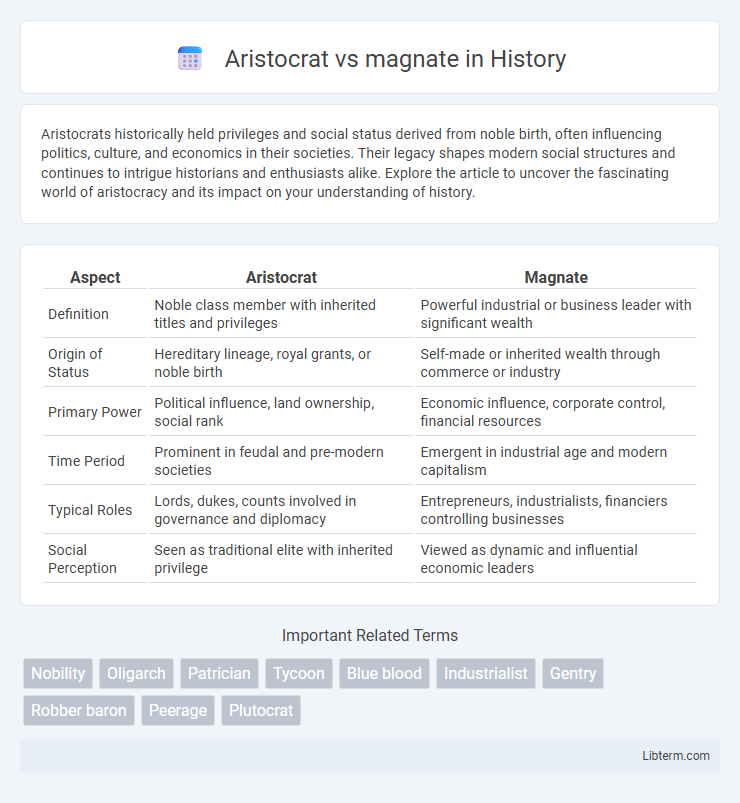Aristocrats historically held privileges and social status derived from noble birth, often influencing politics, culture, and economics in their societies. Their legacy shapes modern social structures and continues to intrigue historians and enthusiasts alike. Explore the article to uncover the fascinating world of aristocracy and its impact on your understanding of history.
Table of Comparison
| Aspect | Aristocrat | Magnate |
|---|---|---|
| Definition | Noble class member with inherited titles and privileges | Powerful industrial or business leader with significant wealth |
| Origin of Status | Hereditary lineage, royal grants, or noble birth | Self-made or inherited wealth through commerce or industry |
| Primary Power | Political influence, land ownership, social rank | Economic influence, corporate control, financial resources |
| Time Period | Prominent in feudal and pre-modern societies | Emergent in industrial age and modern capitalism |
| Typical Roles | Lords, dukes, counts involved in governance and diplomacy | Entrepreneurs, industrialists, financiers controlling businesses |
| Social Perception | Seen as traditional elite with inherited privilege | Viewed as dynamic and influential economic leaders |
Definition of Aristocrat and Magnate
An aristocrat is typically defined as a member of a noble class, often holding hereditary titles and privileges linked to social hierarchy and governance. A magnate refers to an individual of great influence in business or industry, known for substantial wealth and control within a specific economic sector. While aristocrats derive status from lineage and tradition, magnates gain prominence through economic power and entrepreneurial success.
Historical Origins and Evolution
The term "aristocrat" originates from the Greek word "aristokratia," meaning rule by the best, historically referring to a hereditary ruling class distinguished by noble birth and social privileges in ancient civilizations like Greece and medieval Europe. In contrast, "magnate" derives from the Latin "magnates," meaning great men, initially signifying powerful feudal lords or influential merchants whose status was based more on wealth and political influence than noble lineage. Over time, aristocrats maintained traditional privileges tied to lineage, while magnates evolved as influential figures through economic power, shaping political and commercial landscapes across different historical periods.
Social Status and Influence
Aristocrats hold social status through hereditary titles and lineage, often enjoying long-established privileges within elite circles. Magnates gain influence primarily through amassed wealth and control over industry or business sectors, shaping economic and political landscapes. While aristocrats symbolize traditional prestige, magnates wield power rooted in modern economic dominance.
Sources of Wealth and Power
Aristocrats derive their wealth and power primarily from hereditary land ownership and noble titles passed down through generations, securing social status and political influence within traditional hierarchies. Magnates accumulate wealth and authority through substantial business enterprises, industrial ventures, or financial investments, often leveraging capitalist market dynamics for economic dominance. While aristocrats rely on inherited privilege and feudal systems, magnates obtain power through entrepreneurial success and control over key economic resources.
Roles in Society and Governance
Aristocrats traditionally hold hereditary titles and govern through inherited privilege, often shaping legislative and judicial frameworks within a monarchy or oligarchy. Magnates, by contrast, amass influence primarily through economic power and control over industries such as finance, mining, or media, impacting society through wealth and patronage rather than formal political office. Both roles shape societal hierarchy, but aristocrats enforce established social orders while magnates drive economic and sometimes political change through capital and enterprise.
Cultural Perceptions and Stereotypes
Aristocrats are often culturally perceived as members of hereditary nobility adorned with long-standing traditions, refined manners, and a sense of duty tied to lineage and social hierarchy. Magnates, in contrast, are stereotyped as powerful business tycoons who accumulate wealth through entrepreneurship and influence modern economic landscapes, often seen as self-made rather than born into privilege. These differing cultural perceptions reflect a divide between inherited status symbolized by aristocrats and meritocratic success embodied by magnates.
Key Differences and Similarities
Aristocrats and magnates both occupy high-status positions, but aristocrats are members of hereditary nobility, often linked to traditional titles and land ownership, whereas magnates achieve influence primarily through business success and wealth accumulation. Both share considerable social power and influence, yet aristocrats' status is typically inherited, while magnates' prominence is usually self-made or earned through commerce. The key difference lies in the source of their authority: aristocrats derive it from lineage and social class, magnates from economic dominance and entrepreneurship.
Notable Aristocrats and Magnates in History
Notable aristocrats like Marie Antoinette and the Duke of Wellington shaped European history through their influence in royal courts and military leadership. Prominent magnates such as John D. Rockefeller and Andrew Carnegie revolutionized the industrial era with their vast wealth and business empires in oil and steel. These figures exemplify the distinct power dynamics where aristocrats held inherited social status, while magnates acquired dominance through economic success.
Impact on Modern Society
Aristocrats historically shaped social hierarchy and governance, influencing modern legal systems and cultural norms through inherited privilege and landownership. Magnates, driven by economic power in industries such as finance, technology, and media, have significantly impacted contemporary markets, innovation, and global business practices. The shift from aristocratic to magnate influence underscores the transition from hereditary authority to wealth-based power, reshaping societal values and opportunities in the 21st century.
The Future of Aristocrats and Magnates
The future of aristocrats and magnates is increasingly shaped by globalization, technological innovation, and shifting socio-economic power dynamics. Aristocrats may leverage their historical prestige and legacy assets to influence cultural and philanthropic sectors, while magnates continue expanding their influence through tech-driven industries and capital investment. Emerging trends suggest a convergence where both groups adapt by embracing digital transformation and socially responsible business practices to maintain relevance and impact.
Aristocrat Infographic

 libterm.com
libterm.com